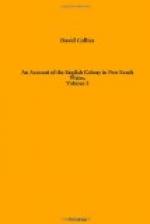The great bulk of these blocks renders them so conspicuous, that the attention is first struck with them upon approaching the island. But, besides granite, there is on the north side, where the island is particularly low and narrow, a slip of calcareous earth, of a few hundred yards in length, which discovers itself near the broken surface of the water. It is not for the most part pure, for broken pieces of the granite are mixed with it in various proportions. Some parts are a mere mass of these broken pieces cemented together by the calcareous matter; whilst others are an almost perfect chalk, and are capable of being burnt into excellent lime. Broken sea shells and other exuviae of marine animals are apparent throughout the whole mass.
Upon the beach at the foot of this chalky rock, was found a very considerable quantity of the black metallic particles which appear in the granite as black shining specks, and are in all probability grains of tin.
To find this small bed of the remains of shell animals, of which chalk is formed wherever found, in such an unexpected situation, excited some surprise; and Mr. Bass endeavoured to investigate the cause of this deposit, by examining the form of the neighbouring parts of the island.
The result of his inquiries and conjectures amounted to this: that as traces of the sea, and of the effects of running waters, were plainly discernible in many parts of the island, and more particularly in the vicinity of this deposit of chalk and granite, it seemed highly probable that it had been formed by two streams of the tide, which, when the island was yet beneath the surface of the sea, having swept round a large lump of rocks, then met and formed an eddy, where every substance would fall to the bottom. The lump of rocks is now a rocky knoll, which runs tapering from the opposite side of the island toward the chalk. On each side of it is a gap, through which the two streams appear to have passed.
The vegetation on the island seems brown and starved. It consists of a few stunted trees; several patches of brush, close set and almost impenetrable; large tufts of sour and wiry grass, and abundance of low saltish plants, chiefly of the creeping kind.
A small spot upon the east end of the island presented a phenomenon which seemed not easily explicable by any known laws of that class of natural history to which it alone was referable.
Amidst a patch of naked sand, upon one of the highest parts of the island, at not less than 100 feet above the level of the sea, within the limits of a few hundred yards square, were lying scattered about a number of short broken branches of old dead trees, of from one to three inches in diameter, and seemingly of a kind similar to the large brush wood. Amid these broken branches were seen sticking up several white stony stumps, of sizes ranging between the above diameters, and in height from a foot to a foot and




